Asif Kapadia Diego Maradona
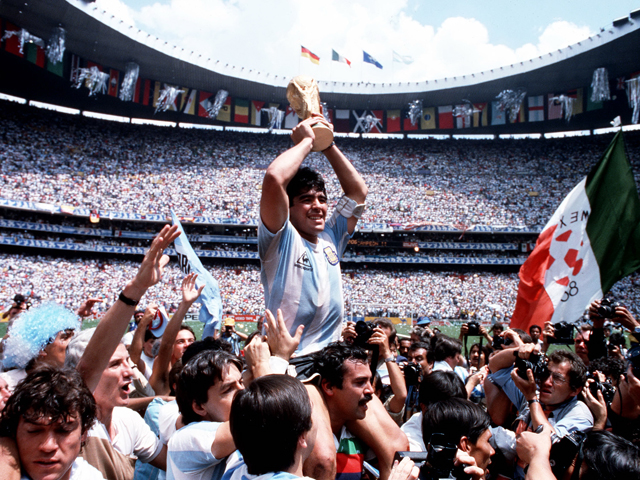
Rebel. Hero. Hustler. God.
Cast: Diego Armando Maradona
Director: Asif Kapadia
Genre: Documentary, Sport
Running Time: 130 minutes
Synopsis: Diego Maradona was considered the best player in the world from the moment he burst onto the scene in his native Argentina. And yet success proved elusive. He failed at Barcelona. He was considered a problem player, too interested in partying.
Meanwhile, having never won a major tournament, the ailing Italian football giant SSC Napoli were perennial underachievers. Their fanatical support was unequalled in both passion and size. But how they ached for success…
On 5th July 1984, Diego Maradona arrived in Naples for a world-record fee and for seven years all hell broke loose. The world's most celebrated football genius and the most passionate but dangerous city in Europe were a perfect match for each other.
Diego Maradona was blessed on the field and treated like a God off it; the charismatic Argentine loved a fight against the odds and led Naples to their first-ever League title. It was the stuff of dreams. But there was a price…
Diego could do as he pleased while performing miracles on the pitch, but as time passed, darker days closed in. Italy turned on him.
The third film from the Academy Award-winning & multi-BAFTA-winning team behind Senna and Amy (director Asif Kapadia, producer James Gay-Rees, editor Chris King, composer Antonio Pinto), and also Paul Martin, Diego Maradona was constructed from over 500 hours of never-before-seen footage from Maradona's personal archive.
Diego Maradona is crafted in the style of Senna and Amy. It is the definitive feature documentary on the charismatic enigma that is Maradona.
In a city where even the devil would need bodyguards, Diego Maradona became a god.
Maradona in Naples is the story of his life, the wild and unforgettable story of an unrivalled talent. He was a rebel, cheat, hero and god. This is a story of glory, despair and betrayal, a tale of corruption and, ultimately, of redemption.
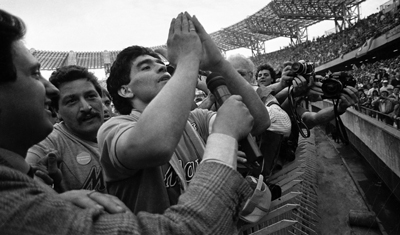 About The Production
About The Production
Diego Maradona marks the third instalment in a trilogy of innovative, hard-hitting feature documentaries from the Academy Award-winning team behind SENNA (2010) and AMY (2015) " Asif Kapadia (director), James Gay-Rees (producer), Chris King (editor) and Antonio Pinto (composer).
And once more they tackle a larger-than-life icon, someone whose immense talent has affected millions, inspiring and exciting audiences all around the globe, and living a life that unfolds against a backdrop of controversy and tragedy.
Maradona is a household name, lauded as one of the greatest footballers ever to grace the game, a man who has smashed transfer records, dragging an under-achieving Italian football club, Napoli, to title-winning glory and claiming the 1986 World Cup for his native Argentina almost single-handedly.
And yet his is also a life shadowed by domestic disputes, cocaine addiction and dealings with shady, underworld characters. Wherever he goes, contention follows. He is a darling of the press and also a marked man. His turbulent life is a perfect subject for Kapadia's critical eye.
As with SENNA and AMY, Kapadia has sought to reveal the humanity of a creative genius, crafting a film that will carry its subject to new audiences, intriguing not only football fans, but also those who have no interest in the game. DIEGO MARADONA tells of a man who transcends the arena in which he made his name.
Here is the story of a poor, uneducated kid from a shanty town whose dazzling excellence rocketed him to superstardom, bestowing upon him untold riches, worldwide fame and a God-like status. And yet he lacked the tools with which to cope with such celebrity. Each triumph in his life is seemingly chased down by disaster – though he usually wins through in the end because, as Kapadia notes, "He is so streetwise and street-smart. No matter how many times he falls, he gets back up and carries on.
How could anyone come from his background, go through everything that he went through in his life and not be affected by it?" he asks. Though Maradona suffers a string of defeats he always battles back. "He is a true fighter," says Kapadia, "and his is a story I was desperate to tell."
Kapadia was first approached to make a Maradona movie by producer Paul Martin during the London Olympics in 2012, not long after the release of SENNA. Martin had uncovered a collection of remarkably candid footage, almost entirely unseen by audiences, and believed that Kapadia would be the ideal candidate to helm a feature documentary with this footage at its core.
"Paul and I spoke for a while but at that point I had just done a sports film and I wasn't in a hurry to do another one, even though I've always found Maradona a fascinating character," Kapadia recalls. "Having just made a film about a Brazilian racing driver, to make one about an Argentinian football player? I just wasn't sure that the timing was right. I wanted to do something a little different and so we made AMY."
In the meantime, Martin, who has a background in football, produced RONALDO (2015), with Kapadia and Gay-Rees executive producing. Martin and Gay-Rees also produced the Steven Gerrard documentary MAKE US DREAM (2018).
Martin did not, however, give up on the idea of making a Maradona documentary with Gay-Rees and Kapadia. "Paul started on this process a long time ago," says Gay-Rees, "and while I spoke to him during our editing process on AMY, we didn't have time to pursue it. We then worked on other things together but he did eventually end up getting access to this amazing collection of footage of Diego Maradona."
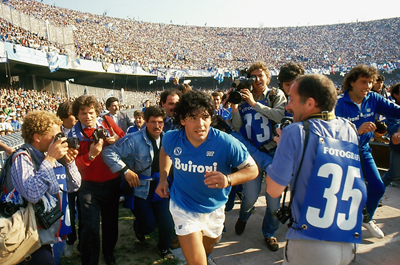 Martin recalls first hearing about what he describes as this "near-mythical" footage while working as a football journalist prior to becoming a filmmaker. The footage had been shot by two cameramen, Argentine Juan Laburu and Italian Luigi 'Gino' Martucci, at the behest of the late Jorge Cyterszpiler, Maradona's lifelong friend, who had operated as his first agent and who brokered his move to Boca Juniors and his world record transfers to Barcelona and then Napoli.
Martin recalls first hearing about what he describes as this "near-mythical" footage while working as a football journalist prior to becoming a filmmaker. The footage had been shot by two cameramen, Argentine Juan Laburu and Italian Luigi 'Gino' Martucci, at the behest of the late Jorge Cyterszpiler, Maradona's lifelong friend, who had operated as his first agent and who brokered his move to Boca Juniors and his world record transfers to Barcelona and then Napoli.
"Jorge was a slightly more middle class kid from Buenos Aires who befriended Diego as a really small kid," explains Kapadia. "Jorge helped him become a professional footballer and then sought out commercial deals with Puma and Coca Cola. He did all these things way ahead of his time."
Among Cyterszpiler's many ventures during the early 1980s was the hiring of two cameramen to document Maradona's life. "They began filming on U-matic," says Kapadia, "an old video format that was popular in the '80s, and they shot hundreds of hours of footage from 1981/1982 right on up to his career in Naples in about 1986, 1987."
Maradona eventually dispensed with Cyterszpiler as his agent and hired Guillermo Coppola. The filming stopped. "But there was so much wonderful footage," continues producer Paul Martin. "Cyterszpiler always had this idea of creating a great film. Juan had begun filming with Diego in Buenos Aires, then in Barcelona and then he came over to Naples before Gino took over."
"Between them they had been filming Diego for a long, long time and they had the foresight to shoot him at the peak of his footballing abilities."
Cyterszpiler had the vision to make a film way back in 1981 but it has taken almost 40 years for a true, in-depth cinematic feature to come to life. "In many ways," notes Kapadia, "we took on the job that Jorge started."
A key moment in that odyssey came when Martin and James Gay-Rees finally sat down with the two cameramen and saw what was available. They immediately sought access to the entire archive. "There were a lot of legal considerations to discuss with Maradona's lawyer, deciding over the ownership," says Martin. "But we got there in the end."
As it transpired, acquiring the footage was just the first step down a long and winding path. Gay-Rees recalls, "Everything that Juan and Gino had was so disorganized. They had duplicates. There were things cut in half. There were different versions of the same things and it was all a bit amateur. But, importantly, there was a lot of homegrown material."
That was the turning point. "We thought that this intimate footage felt like the inside track, if you like, on his personal archive. That was the meat and potatoes of that magical Naples period, right there."
For the film's editor, Chris King, the footage from his time in Naples was unsurpassed. "There is lots of black-and-white footage of him as a kid in Argentina, which you see in our pre-title sequence, and you can see that he is quite shy and introverted, unused to being on camera."
"Then there was the 1978 World Cup and him not being picked, and then his early matches. All of that was interesting, but suddenly you get to Naples and you are in the room with him. You are in the car with him. You are travelling around with him and you are in his life. Immediately, that was more fascinating, seeing his arrival there, getting off planes and going in to have his medical, having his blood taken. It is unbelievable footage."
"I knew immediately that we would need to start the film by intercutting with his arrival in Naples," continues King. "And then also you have the burning question of why a huge player like Maradona is going to an underachieving club like Naples. It straight away raises questions, which the film can then go on to answer."
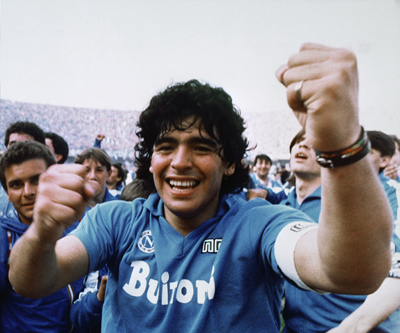 A Trinity Of Icons
A Trinity Of Icons
Diego Maradona is a different character from both Ayrton Senna and Amy Winehouse, and his story " though framed by elements of tragedy " is still on going. And yet, both Kapadia and Gay-Rees believe that Diego Maradona completes a trilogy of sorts, alongside their two existing feature documentaries, their breakout piece SENNA and their Oscar®-winner AMY. "I do consider them a trilogy," Kapadia affirms. So too does Gay-Rees: "For me, this film is like the child of SENNA and AMY."
Diego Maradona is an icon, a Latin hero, a man of whom so many of his countrymen and women are fiercely proud. He took on European giants, toppling the might of Juventus, AC Milan and Internazionale with his sporting excellence. In Naples he became something approaching a demigod. "And yet still he doesn't ever quite fit in," says Kapadia. "He carries anger and all his problems and issues come, I think, with being unprepared for fame."
"He is brilliant and yet self-destructive," the director continues. "And what's really interesting is that when you look at him at the height of his achievements and when things start to go badly wrong for him, it's when he denies his son."
The son was Diego Armando Maradona Sinagra, who was born in September 1986 from Maradona's extra-marital affair with local woman Cristiana Sinagra while he was playing in Naples. The footballer's refusal to accept the boy as his biological offspring sits at the heart of Kapadia's movie.
An Italian court recognised Maradona's paternity in 1993, but the pair only met for the first time in 2003, "and it is just my personal theory from spending years and years watching these people," continues Kapadia, "but I do think that the thing that perhaps caused or at least aggravated Maradona's problems was denying the child."
A major difference between the subject of his latest film and the two earlier feature documentaries is that while both Ayrton Senna and Amy Winehouse died at the peak of their careers, Maradona is still alive, albeit living out something of a public decline.
"It is an interesting point," the director says. "What happens if you are an amazing sports star and you get old and you lose it? I think that is all part of this story and what makes Diego an even more complicated character."
Maradona divides opinion like few others. "He is not necessarily so easy to like and to be sympathetic towards," continues Kapadia. "It can be hard to accept some of the decisions he makes. And yet people are fascinated with this flawed genius. What is it about him? Why do I find him fascinating and interesting? He is unconventional. He is a streetwise street kid and he always will be. He will rub you up the wrong way."
In many ways, that is pivotal to Maradona's appeal. "He doesn't play to the crowd. He does the opposite of what everyone wants or expects and that's why people love him and hate him. That's why he is so interesting and is so controversial."
Further symbiosis emerged during the course of making the film, says Kapadia, when he learned that Maradona was a huge fan of Senna, both the man and, consequently, of Kapadia's 2010 movie.
"He said that he wanted to call his second child Ayrton, if it were a boy," Kapadia says. "There are photos of him going to Senna's grave and putting flowers on it. He was a big fan. And as we were researching this I realised that their two stories were running parallel."
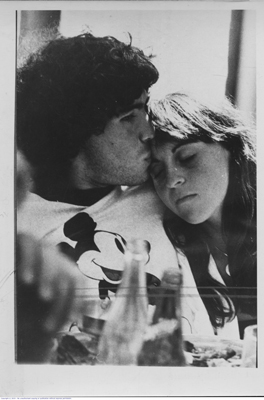 "Senna was winning world championships and Diego was winning the title in Italy. And F1 is big in Italy. Whenever we did the research on the sports pages, Ayrton and Diego shared those same pages. They went after the same girls. They never met. I asked him. They just missed each other."
"Senna was winning world championships and Diego was winning the title in Italy. And F1 is big in Italy. Whenever we did the research on the sports pages, Ayrton and Diego shared those same pages. They went after the same girls. They never met. I asked him. They just missed each other."
That Maradona's story is still running created an editorial conundrum for the filmmakers that did not exist with their first two feature documentaries. With Diego Maradona, what was the end point? "You think you have it and then he does something else crazy," says Kapadia, "so one of the big challenges was: how do we end this film? Where does it go up to? He goes on forever."
Just consider the summer of 2018 when he had attracted mass international news coverage with his antics at the World Cup in France. "We were editing, sitting in this room and watching the World Cup and whenever Argentina played they were constantly cutting to Diego," says the director.
"But in a way it helped us because that's in the film and that's him. That's the guy; that's Maradona. It gave us the idea on how to close the film, which is to acknowledge that he will always be like that." The chaos, the genius, the media's and the world's endless fascination with him – that is Diego Maradona. He is unique.
Finding Diego
With Maradona leading such a tumultuous life, the filmmakers were faced with the difficult choice of where to focus their editorial. His rise from street kid to home-based superstar at Boca Juniors is a pivotal journey, and a priceless rags-to-riches story, while his world record transfer to Barcelona and his tempestuous spell with the Catalan giants is riddled with controversy, not least a notorious on-pitch brawl that features in the movie.
However, they decided that the heart of Maradona's story, encapsulating his greatest triumphs, and his biggest fall from grace, came during his time in Italy.
"That archive to which we got access clearly focuses on that crazy period in Naples although there were times when we were looking to open up the narrative on the whole story," says Gay-Rees. "But we had so much good footage that happened in Naples, and we wanted to make a feature documentary, so we focused most of our attention on that period."
Between 1984 and 1991, Maradona would make almost 200 appearances for Napoli, propelling a perennially underachieving team, a side that had never won a championship, to the apex of the Italian league, while also dragging Argentina to World Cup glory during Mexico '86. Alongside the glory, meanwhile, a series of disasters emerged.
Naples itself was a violent town, despised by many northern Italians, who regarded its inhabitants with a disdain bordering on racism. The football club had never achieved a Scudetto (or Italian championship).
While in Naples he had the affair with Sinagra. He became involved with the Camorra, an Italian crime syndicate that dominated many aspects of Neapolitan life. He descended into a spiral of drug abuse. During the Italia '90 World Cup his adopted country turned against him as Italy faced Argentina in the semi-final, played in Naples of all places.
"To his credit, James always said that the story was his time in Naples," says Kapadia, "but I had to research his whole story. I wanted to see his rise and what a star he was at Boca. Then why did it go wrong in Barcelona? What happened afterwards? Where does it begin and end. The story is massive."
According to Kapadia, many Argentinians would say that the story with Maradona is the one before Naples, "a young kid who was amazing, who everyone saw as great. Then the Italians would say, 'No, no, it's just Naples, winning the first title.' And then others say, 'No, it is a great World Cup won by a single player,' or that it is his time in Cuba, or how he is now."
Yet Naples is undoubtedly the heart of his story. King agrees. "The Naples story exemplified everything," says the film's editor. "It was the highlight and the highest and lowest points of his story, and really the beginning of the end. Everything that came after that was just a play out of the same thing."
Trying to capture everything that came after Naples was not necessary for their narrative. "We realized there is a kind of depression that comes in with addiction," continues King, referencing the cocaine problem with which Maradona became saddled during his time in Italy.
"And with that depression people start to repeat the cycle. And so we would just be watching someone get slightly better and then relapsing and then getting slightly better and relapsing. That is what happened with Maradona. He would get another gig and get another football club, get slightly better, then relapse and then he'd leave that club and go somewhere else."
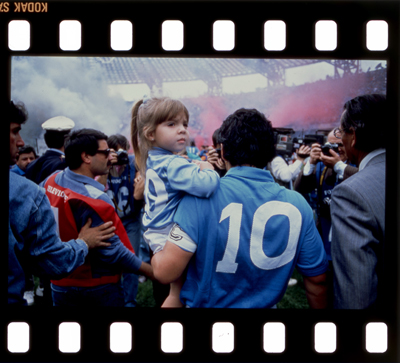 Kapadia agrees. The footballer's time at Napoli unfolded as something of a microcosm of the cycle of triumph and disaster that frames almost every period of his life. "He needs someone to fight," says Kapadia. "He will find someone everywhere he goes, though somehow he managed to stay for seven years at Naples before that big semi-final when the whole country started to turn on him."
Kapadia agrees. The footballer's time at Napoli unfolded as something of a microcosm of the cycle of triumph and disaster that frames almost every period of his life. "He needs someone to fight," says Kapadia. "He will find someone everywhere he goes, though somehow he managed to stay for seven years at Naples before that big semi-final when the whole country started to turn on him."
Recounting all the ups and downs outside his time in Italy would also be impossible with a feature-length cinema documentary. "You have to pick your battles and you have got to condense the story," explains Kapadia. "You can't put everything in. I researched his entire life and to tell the entire story we would be looking at something like a fivehour film or a six-part TV series.
"But I am old school. I like theatrical releases. I like seeing things on at the cinema with audiences. And I think Diego is a movie star in the same way that Amy and Senna were. I want to see him on the big screen; that was important to me."
"All of these films are about people who maybe when we started the film were not necessarily loved but people were converted," he notes. "People who were not Amy fans or racing fans realized that these characters are really interesting. And so much of Diego's story feels cinematic."
The end of his time in Italy plays like a film thriller. Here was a man who had arrived in Naples as a hero, with 80,000 people crowding into the football stadium in a bid to see a star. When he left, he slipped out of the country unnoticed and completely alone.
"The undercurrent of the film is a bit like Mean Streets," says Kapadia. "Naples in the '80s was one of the most dangerous places in Europe and yet here they were with the best player in the world going to a team that has never won anything."
And yet while Naples was the crux of the story, Maradona's life in Argentina, before and after Italy, cannot be overlooked. "The voices are all Argentinian," continues the director. "His ex-wife lives in Argentina. His daughters are there and much of the footage we ended up using was there. So in order to tell the story in Naples you have to go to Argentina."
Meeting Diego
Making a film with a living icon offered Kapadia an editorial avenue that was denied to him on SENNA and AMY: conducting fresh interviews with his primary subject.
Meeting Maradona is no easy task, although the filmmakers were helped by the fact that the footballer loved SENNA and enjoyed the fact that team had won an Oscar® for AMY during the negotiation process.
"On his Facebook page and Instagram page there was a picture of us getting the Oscar® and he was saying, 'These guys are going to make a film about me next.' So we spent a lot of time interviewing him in Dubai where he was living."
Conducting the conversations proved a challenge. "It seems that there is an archetypal way you meet him," Kapadia explains. "You arrive and his team would say, 'No, no, he's not feeling good today. Try tomorrow.'"
And so the process repeats. Eventually, though, Maradona and Kapadia came face to face, conducting a number of indepth interviews. Not surprisingly, he proved a mercurial subject. "You forget how many people Maradona meets," the director says, "and the things he has been through, the things his body has been through."
Still, it was up to Kapadia to persist and also to insist that his subject spoke about the most controversial and sensitive aspects of his personal life: why he ended up in Naples, the match against England at the '86 World Cup, his family, the women, drugs, problems with his children. As with the people he spoke to for his previous films, Kapadia had to build trust.
"It was a very similar process to what we went through before," he says. "I don't take a camera. I just talk to people, build up trust and try and explain that we are telling a story. We are not taking sides. We want the truth to come out and we want everyone to be part of it."
In order to fully explore Maradona's boisterous existence, the filmmakers also needed access to those who had been close to him during his time in Naples, particularly his ex-wife, Claudia Villafañe, and his ex-girlfriend and mother of the child he denied, Cristiana Sinagra, as well as the children themselves.
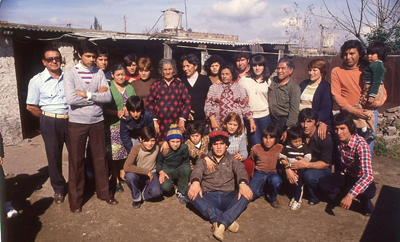 "It only works, and we can only make a definitive film of Diego, if everyone talks to us," Kapadia concedes. "To make a film without Claudia would be wrong. She was with him since the age of 15. They are still connected and they have two daughters."
"It only works, and we can only make a definitive film of Diego, if everyone talks to us," Kapadia concedes. "To make a film without Claudia would be wrong. She was with him since the age of 15. They are still connected and they have two daughters."
Villafañe also had some very revealing footage that the filmmakers wanted to see. Getting these other parties to agree to meet, however, was a herculean task. "The only way to do it was to tread really carefully and sensitively, meeting them, talking to them, interviewing them, letting them say their story. It has been a long process, taking more than three years."
In fact, Kapadia concedes that this film has proved even more complicated than SENNA and AMY. "Even though Senna was Brazilian and I did interviews in Brazil, mainly in San Paulo, and the languages were Portuguese and French, we were mainly speaking English. And, vitally, the SENNA footage was mostly here in the UK. And with AMY, that is really a North London film, and everything was in English.
"With this one," he adds, "it is all in Italy, and especially Naples, which is a pretty tricky city. Then we had to deal with Buenos Aires. And the language of the film was almost entirely Spanish and Italian, which was challenging for me when conducting interviews, when trying to build up a relationship with contributors, and later on for the editor, Chris."
To bring his film to life, and to track down and recruit all the contributors he required, Kapadia turned to his two archive producers and researchers, the Colombian Lina Caicedo, who focused on Argentina, and the Italian Fiammetta Luino, who worked in Italy.
Revealing Diego
Having secured the footage of Maradona shot by Laburu and Martucci, the filmmakers turned their attention to securing the input of those to whom Maradona had been close " especially Cristiana Sinagra and Claudia Villafañe, the latter possessing her own archive of invaluable footage.
"We had heard that Claudia had a trunk full of tapes," says Kapadia, "and no one had ever had access to them. So we had to build up a relationship with Claudia to see what she had, which was especially difficult at the time because she and Diego were no longer together."
"We had to bring huge U-matic machines over from the UK, as we didn't know if any existed in Buenos Aires, in order to see what was actually on these tapes, which hadn't been viewed in 30 years. As well as speaking with Claudia, we also interviewed Diego's daughters."
In fact, Lina Caicedo counts her success bringing Claudia on board as one of her greatest achievements on the film. "Getting through to his ex-wife was a difficult job, but vital," she says. "Not only was she important to the story but she also had her own personal archive material. Claudia had never ever contributed to anything like this before, so we had to gain her trust."
"We just had to get her on board," Caicedo continues. "It took a whole month and even two days before I left Argentina I still hadn't locked her down. Finally, she decided to see me and we ended up chatting for five hours. In the end she agreed to an interview with Asif and we slowly worked towards digitising some of her archive."
Even then, further challenges remained. The filmmakers needed access to material from Argentinian broadcasters, for example, yet when they came to finish the film they discovered that all the archivists at one of the public broadcasters had gone on strike. "And we were told we wouldn't be able to get the master material until the following year," Caicedo says. 'Nothing is easy on a film like this."
Her Italian co-worker, Fiammetta Luino, concurs. It fell to her to secure Cristiana Sinagra's contribution. "That took around six months," she explains, "and to begin with there was a very clear 'No!' Hers is a very delicate story."
Neither Sinagra nor their son had ever contributed to a big story on Maradona. "Until then, their story had been relegated to the gossip columns," Luino explains, "so bringing them on board was about us showing that we were sincere, and that we believed they were a significant part of Maradona's life in Naples."
One other key contributor with whom Luino had to work was Gennaro Montuori, a prominent member of the Napoli Ultras, a supporter group that boasts immense power within the club, and which was especially potent during the halcyon years when Maradona played.
"Montuori was head of the Napoli Ultras," says Kapadia. "He comes from the roughest part of Naples and is one of the fans who would 'direct' the other fans in one of the ends of the stadium. But he was friends with Diego, who came to his house for dinner, and he's so connected to the team that he is there in the changing room when they win the first Scudetto."
"And, luckily for us, he would film everything. He's got loads of material on VHS that no one has seen because he wouldn't show it to anyone else. The footage is fantastic as no one could get that level of access. All this private footage is so important to the story we wanted to tell. It adds texture and gets you in there with him."
The sources that the Diego Maradona team have accessed have created an unparalleled level of access. There is a scene with Maradona at a bowling alley. We see him at home with his children and out playing tennis with his wife.
There is a shot before the World Cup Final in 1986 where he's geeing up the team. There's footage of him in the dressing room winning the Scudetto for the first time and footage of him sitting on the bed with the World Cup. So much of this is previously unseen and reveals important aspects of his character.
Crucially, there is also what Kapadia describes as their "Long Good Friday shot", which they obtained from Montuori, where Maradona is out with his Napoli team mates towards the end of his time in Italy. While the other players celebrate over dinner, the camera spends what seems like an age watching the Argentine gaze into the middledistance, apparently aware that his life is about to change forever.
Even the football footage is remarkable. Gino Martucci had been hired to film Maradona on the pitch and his contribution supplies a clutch of amazing, tightly focused clips, where the audience can marvel at Maradona's magic in the face of brutal on-field treatment.
"He was playing at a time when there weren't loads of cameras in the stadium. We didn't want to use wide shots of the whole game and we were so lucky to have had this footage where we are just in close on Diego, watching him. Our editor, Chris King, works this brilliantly."
King says that the football footage was fascinating. "Gino shot that at the side of the pitch. It is intimate. You are down at pitch level. We really wanted to feel the crunches and the feet hammering on the turf, people smashing into each other. The moment you cut to the traditional top shot from the stands, which showed you the whole view from the pitch, you felt the tension disappear. It was uninvolving."
"But when you are down there, pitch-side, and there are people crossing the camera, it is hand-held, you feel as if you were really there. We really wanted to make it feel like you were there on the pitch with him rather than a spectator in the stands."
This footage reveals Maradona's on-pitch wizardry. "He had speed and technique and he had this idea of finding the right balance to beat everyone he played against," adds Kapadia. "A lot of people, particularly if they don't like football, can see his genius in the footage from Gino."
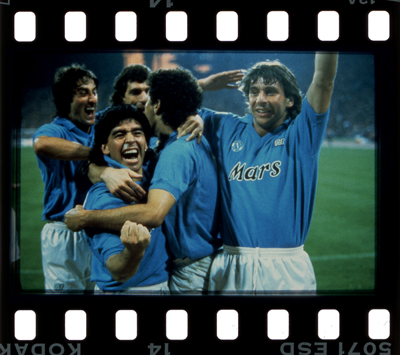 Diego Vs Maradona
Diego Vs Maradona
Like many viewers, no doubt, the filmmakers and archive producers sometimes found it difficult to like Maradona. This was especially true for Luino and Caicedo and yet both found his life mesmerising.
"I guess I struggled with the fact that he is very tied up to a kind of machismo, which is destructive and quite painful to watch," says Caicedo. "But you realise that this narrative, particularly within the South American patriarchy is quite common and at times can manifest itself into self-destructive behaviours " drinking, drugs, violent outbursts and not being able to show any sort of vulnerability."
"This machismo and inability to ask for help in the end destroys and limits you and you can see this in him. He still hasn't properly dealt with his demons. But I do feel compassion towards him because he was never given the tools to even begin to know how to unpick some of his painful past."
Luino agrees, adding, "Despite everything, what a mark this man has left on people's lives; the weight and aura is intact. Speaking to these people you realise that their attraction to this guy is still palpable. " "No matter if you like him, hate him, approve of him or disapprove, you realise that this guy had amazing energy and charisma and you can still see that in the eyes of people that knew him 30 years later."
King, meanwhile, says that he has learned to feel compassion for Maradona. "I feel quite sorry for him now because he did have a rough hand," he says. "You learn what he went through and learn why he picked up the habits that he did, and realise that he didn't get treatment for any of those habits. He has never really been treated, as far as we can work out. He never successfully addressed his real problems. He never had an opportunity to."
"He was the architect of many of his own downfalls but even then, Asif and I had to keep reminding ourselves that at the age of 24 he was already an international figure carrying the expectations of a nation and of hundreds of thousands of football fans each week."
"He was remarkably eloquent for an uneducated 24-year-old so you forgot that he was that young. Although he makes mistakes, which of us can say that we didn't make any mistakes in our 20s and didn't experiment and get it wrong?"
When learning to understand the underlying complexity that defines their subject, the filmmakers took much from Maradona's former fitness coach, Fernando Signorini, who in the film points out there are almost two different people wrapped up in one man: the pleasant, fun-loving Diego and the embattled, ever-striving, ever-fighting Maradona.
"Signorini explains why there are these two different characters wrapped up in this man," says Kapadia. "And he is caught in a cycle of repetition: glory, death and resurrection. As soon as you think he's down and out he'll come back and surprise you. He needs both sides of his personality to survive and to be successful. At the beginning of the film he says that football is a game of deceit. That's how Diego lived and played, on and off the pitch."
The infamous game against England in the 1986 World Cup is a case in point. In one game we see the deceit with the 'Hand of God' where he leaps and punches the ball past Peter Shilton in the England goal. Then comes the moment of magic where the hard-working genius, a man who had trained at altitude prior to the tournament and who across the years had honed mind-boggling skills, slaloms past half the England team to score one of world football's greatest goals.
"One of our contributors Daniel Arcucci, Maradona's friend and biographer, said that you have a great player like Lionel Messi, perhaps the greatest player of his generation," says Kapadia, referencing Barcelona's current highly lauded Argentine star.
"But no matter what Messi does he will never win the World Cup having dragged an ordinary team through a tournament, having beaten England along the way with two goals, one with his hand " the 'Hand of God' – and the other one of the greatest goals of all time. And he did this just four years after the war between Britain and Argentina." For these reasons, many people believe that Messi will never rival Maradona.
MORE



